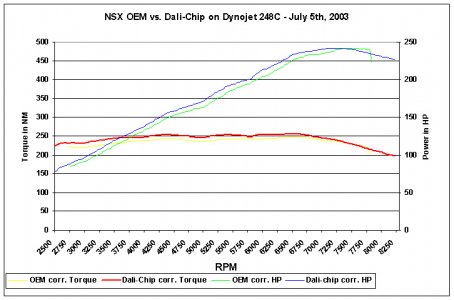Last week I had my car dynoed when it was still completely stock in the power department.
After that, a NSX-friend of mine installed the Dali-chip in it's very neat ZIF-socket. Following my NMP (NSX Modification Plan), I had my car dynoed again last Saturday.
As promised, I have listed the results below.
Several remarks are in order here.
1) Probably due to weather conditions the Dynojet corrected the measured output on the Dali-runs with 2.5% where the original had a correction factor of only 1.7%. Therefore, inititally the gains with the Dali-chip were looking much higher than they actually are.
2) The MAXIMUM HP on my car with the Dali-chip is NOT higher than with the OEM-chip. However, both Torque and HP are 4%-6% higher between 3000 and 5250 RPM. Between 5250-7000 RPM the gains average out to about 2%-4%.
3) The average Torque-gain with the Dali-chip is 5 Nm. The average HP-gain is 5 HP.
Dynamometer Dynojet 248C Dynojet 248 C
Car NSX NA1 NSX NA-1
Modifications None Dali-chip
Date 28.06.2003 04.07.2003
Barometric Pressure 1022.0 mBar 1022.0 mBar
Vapor Pressure 15.0 mBar 15.0 mBar
Intake Temp. 26.6 Celsius 22.5 Celsius
Correction factor 0.98 SAE 0.98 SAE
Measured Corrected Measured Corrected Torque HP
RPM Nm HP Nm HP Nm HP Nm HP gain in % gain in %
2500 234.1 82.2 228.3 80.2
2750 225.6 87.1 221.8 85.7 238.2 92.0 232.3 89.7 4.7% 4.7%
3000 223.2 94.0 219.5 92.5 238.9 100.6 233.0 98.1 6.2% 6.1%
3250 229.4 104.7 225.5 102.9 244.8 111.7 238.8 109.0 5.9% 5.9%
3500 236.2 116.1 232.3 114.2 251.1 123.4 244.9 120.4 5.4% 5.4%
3750 239.4 126.1 235.4 124.0 252.9 133.2 246.7 129.9 4.8% 4.8%
4000 242.7 136.3 238.6 134.0 254.8 143.1 248.5 139.6 4.1% 4.2%
4250 246.0 146.8 241.9 144.4 259.3 154.8 252.9 150.9 4.5% 4.5%
4500 247.0 156.1 242.8 153.5 258.4 163.3 252.0 159.2 3.8% 3.7%
4750 243.1 162.1 239.0 159.4 255.3 170.3 249.0 166.1 4.2% 4.2%
5000 239.2 168.0 235.2 165.2 253.7 178.1 247.4 173.7 5.2% 5.1%
5250 244.1 180.0 240.0 177.0 258.6 190.7 252.2 186.0 5.1% 5.1%
5500 247.4 191.1 243.3 187.9 258.8 199.9 252.4 194.9 3.7% 3.7%
5750 245.5 198.3 241.4 194.9 254.7 205.7 248.4 200.6 2.9% 2.9%
6000 246.6 207.8 242.5 204.3 260.3 219.3 253.8 213.9 4.7% 4.7%
6250 249.0 218.5 244.8 214.9 260.4 228.6 254.0 222.9 3.8% 3.7%
6500 252.7 230.7 248.5 226.8 262.4 239.5 255.9 233.6 3.0% 3.0%
6750 249.7 236.7 245.5 232.7 257.5 244.0 251.1 238.0 2.3% 2.3%
7000 243.3 239.1 239.2 235.1 250.9 246.6 244.7 240.5 2.3% 2.3%
7250 239.9 244.2 235.9 240.1 243.4 247.8 237.4 241.7 0.6% 0.7%
7500 233.0 245.5 229.1 241.3 233.4 245.8 227.6 239.7 -0.7% -0.7%
7750 225.0 244.9 221.2 240.8 221.7 241.2 216.2 235.3 -2.3% -2.3%
8000 210.1 236.0 204.9 230.2
8200 203.6 234.4 198.5 228.6
Avg 240.7 178.5 236.7 175.5 248.0 184.9 241.9 180.3 2.2% 2.8%
Max. 252.9 245.7 248.7 241.6 262.5 247.8 256.0 241.7 2.9% 0.0%
After that, a NSX-friend of mine installed the Dali-chip in it's very neat ZIF-socket. Following my NMP (NSX Modification Plan), I had my car dynoed again last Saturday.
As promised, I have listed the results below.
Several remarks are in order here.
1) Probably due to weather conditions the Dynojet corrected the measured output on the Dali-runs with 2.5% where the original had a correction factor of only 1.7%. Therefore, inititally the gains with the Dali-chip were looking much higher than they actually are.
2) The MAXIMUM HP on my car with the Dali-chip is NOT higher than with the OEM-chip. However, both Torque and HP are 4%-6% higher between 3000 and 5250 RPM. Between 5250-7000 RPM the gains average out to about 2%-4%.
3) The average Torque-gain with the Dali-chip is 5 Nm. The average HP-gain is 5 HP.
Dynamometer Dynojet 248C Dynojet 248 C
Car NSX NA1 NSX NA-1
Modifications None Dali-chip
Date 28.06.2003 04.07.2003
Barometric Pressure 1022.0 mBar 1022.0 mBar
Vapor Pressure 15.0 mBar 15.0 mBar
Intake Temp. 26.6 Celsius 22.5 Celsius
Correction factor 0.98 SAE 0.98 SAE
Measured Corrected Measured Corrected Torque HP
RPM Nm HP Nm HP Nm HP Nm HP gain in % gain in %
2500 234.1 82.2 228.3 80.2
2750 225.6 87.1 221.8 85.7 238.2 92.0 232.3 89.7 4.7% 4.7%
3000 223.2 94.0 219.5 92.5 238.9 100.6 233.0 98.1 6.2% 6.1%
3250 229.4 104.7 225.5 102.9 244.8 111.7 238.8 109.0 5.9% 5.9%
3500 236.2 116.1 232.3 114.2 251.1 123.4 244.9 120.4 5.4% 5.4%
3750 239.4 126.1 235.4 124.0 252.9 133.2 246.7 129.9 4.8% 4.8%
4000 242.7 136.3 238.6 134.0 254.8 143.1 248.5 139.6 4.1% 4.2%
4250 246.0 146.8 241.9 144.4 259.3 154.8 252.9 150.9 4.5% 4.5%
4500 247.0 156.1 242.8 153.5 258.4 163.3 252.0 159.2 3.8% 3.7%
4750 243.1 162.1 239.0 159.4 255.3 170.3 249.0 166.1 4.2% 4.2%
5000 239.2 168.0 235.2 165.2 253.7 178.1 247.4 173.7 5.2% 5.1%
5250 244.1 180.0 240.0 177.0 258.6 190.7 252.2 186.0 5.1% 5.1%
5500 247.4 191.1 243.3 187.9 258.8 199.9 252.4 194.9 3.7% 3.7%
5750 245.5 198.3 241.4 194.9 254.7 205.7 248.4 200.6 2.9% 2.9%
6000 246.6 207.8 242.5 204.3 260.3 219.3 253.8 213.9 4.7% 4.7%
6250 249.0 218.5 244.8 214.9 260.4 228.6 254.0 222.9 3.8% 3.7%
6500 252.7 230.7 248.5 226.8 262.4 239.5 255.9 233.6 3.0% 3.0%
6750 249.7 236.7 245.5 232.7 257.5 244.0 251.1 238.0 2.3% 2.3%
7000 243.3 239.1 239.2 235.1 250.9 246.6 244.7 240.5 2.3% 2.3%
7250 239.9 244.2 235.9 240.1 243.4 247.8 237.4 241.7 0.6% 0.7%
7500 233.0 245.5 229.1 241.3 233.4 245.8 227.6 239.7 -0.7% -0.7%
7750 225.0 244.9 221.2 240.8 221.7 241.2 216.2 235.3 -2.3% -2.3%
8000 210.1 236.0 204.9 230.2
8200 203.6 234.4 198.5 228.6
Avg 240.7 178.5 236.7 175.5 248.0 184.9 241.9 180.3 2.2% 2.8%
Max. 252.9 245.7 248.7 241.6 262.5 247.8 256.0 241.7 2.9% 0.0%






